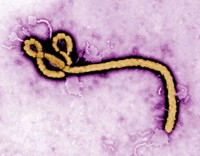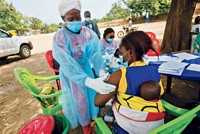Advertisement
Grab your lab coat. Let's get started
Welcome!
Welcome!
Create an account below to get 6 C&EN articles per month, receive newsletters and more - all free.
It seems this is your first time logging in online. Please enter the following information to continue.
As an ACS member you automatically get access to this site. All we need is few more details to create your reading experience.
Not you? Sign in with a different account.
Not you? Sign in with a different account.
ERROR 1
ERROR 1
ERROR 2
ERROR 2
ERROR 2
ERROR 2
ERROR 2
Password and Confirm password must match.
If you have an ACS member number, please enter it here so we can link this account to your membership. (optional)
ERROR 2
ACS values your privacy. By submitting your information, you are gaining access to C&EN and subscribing to our weekly newsletter. We use the information you provide to make your reading experience better, and we will never sell your data to third party members.
Infectious disease
WHO declares mpox a global health emergency
Here’s what you need to know about the infectious disease
by Priyanka Runwal , Alex Viveros
August 19, 2024

On Aug. 14, the World Health Organization (WHO) announced that the mpox outbreaks in the Democratic Republic of the Congo and other countries in Africa are a public health emergency of international concern. It’s the highest level of alarm that the WHO can sound, and it’s the second time in 2 years that the agency has declared mpox a global health emergency.
This year alone, officials have recorded more than 15,600 cases and 537 deaths in Congo—the country most affected by the mpox virus. Meanwhile, nearby countries, including Rwanda, Burundi, Kenya, and Uganda, have reported mpox cases for the first time. “It’s still the tip of the iceberg that we’re capturing,” says Jean Nachega, an infectious disease epidemiologist at the University of Pittsburgh and coordinating committee chair for the African-led multicountry Mpox Research Consortium. “The situation is probably worse.”
Outside Africa, Sweden confirmed the first case linked to these recent outbreaks on Aug. 15. The person had traveled to a part of Africa where cases are surging and was infected during their stay. “It’s clear that a coordinated international response is essential to stop these outbreaks and save lives,” WHO director general Tedros Adhanom Ghebreyesus said in a media briefing on Wednesday.
What is mpox?
Mpox is a disease caused by a DNA virus called mpox that’s closely related to the virus that causes smallpox. It causes flu-like symptoms and a rash that starts out as red spots and transforms into itchy or painful blisters filled with pus that scab and fall off. While most infected people recover within a few weeks, some develop sepsis or brain swelling that can be fatal.
Researchers in Denmark first identified the mpox virus in 1958 when monkeys imported from Singapore for animal research developed pox-like skin eruptions. WHO officials documented the first human case—that of a 9-month-old baby in Congo—in 1970. By 1985, the public health agency had already recorded 310 cases in rural West and Central Africa, where the virus was considered endemic. Case counts have continued to rise, and a 2022 study estimated a minimum 10-fold increase in global mpox cases over the past 5 decades.
These include dramatic surges in Congo, a multistate mpox outbreak in the US in 2003, and the reemergence of the virus in Nigeria in 2017. In 2022–23, a global outbreak led to more than 95,000 cases and 176 deaths across 115 nonendemic countries.
Scientists suspect that rodents may be the primary reservoirs of the mpox virus. The pathogen likely jumps to other animals and humans when they hunt, handle, or eat these infected rodents or get bitten or scratched by them. While researchers have no direct proof of such spread in the wild, the 2003 mpox outbreak in the US was a result of people interacting with infected pet prairie dogs. Meanwhile, some scientists have isolated the virus from forest-dwelling squirrels, rodents, and shrews in Congo, a dead sooty mangabey monkey and human-habituated western chimpanzees in Taï National Park in Côte d’Ivoire.
Among humans, the mpox virus spreads via bodily fluids or skin lesions when people touch, kiss, or have sex with infected individuals or come in contact with their contaminated linens. In the 2022-23 global outbreak, the majority of the cases occurred in men who have sex with men. But anyone in close physical contact with an infected person—irrespective of their sexual orientation—was at risk.
What’s driving the current outbreaks?
Unlike the 2022 outbreak, which was fueled by a type of mpox virus called clade II, the current outbreak is driven by clade I. The clade I virus type is 99.4% genetically similar to clade II but possesses 173 functional unique genes (compared with 171 in clade II) and is associated with more severe disease symptoms and higher death rates. “That’s why the global community is particularly concerned,” says Anne Rimoin, an infectious disease epidemiologist at the University of California, Los Angeles. But she acknowledges that the evidence for clade I’s ferociousness “is not based on great data.”
Similar to previous outbreaks in Congo, most mpox cases are currently in children younger than 15 years of age, largely because these kids were never vaccinated for smallpox, since the disease was eradicated in the 1970s. Scientists have shown that the discontinued smallpox vaccines provide about 85% protection against mpox infections. Another challenge is malnutrition, which makes children more vulnerable to such infections.
But there’s an additional piece to the recent outbreaks that alarmed scientists. Starting September 2023, in Congo’s South Kivu province, public health officials noted an uptick in mpox cases in female sex workers and their clients—young men often from nearby countries working in the province’s mining industry. “It wasn’t like any other outbreak of mpox that we’ve seen [in Congo],” says Laurens Liesenborghs, an infectious disease specialist at Belgium’s Institute of Tropical Medicine who studies mpox transmission in Congo. Typically outbreaks in the region have been associated with animal-to-human transmissions. “It was clear that there was now continued human-to-human transmission [largely though sexual contact].”
Genetic studies revealed that a novel variant of clade I called clade Ib was responsible for the outbreak in South Kivu.. Its genome showed distinct APOBEC3-type mutation patterns, which are a “hallmark of human-to-human transmission,” Liesenborghs says. Clade Ib cases later popped up in Burundi, Rwanda, Uganda, and Kenya, and more recently in Sweden.
Are vaccines and treatments available for mpox?
Public health officials are currently considering two vaccines to combat the spread of mpox in affected African countries. One of them is Jynneos, a two-dose vaccine approved by the US Food and Drug Administration in 2019 to prevent smallpox and mpox in adults. During the 2022–23 global clade II outbreak, more than a million doses were given to high-risk individuals in the US alone. Public health officials expect this vaccine to be effective against clade I as well.
Another option under consideration is a vaccine called LC16 that’s approved in Japan against smallpox and mpox and can be administered as a single dose in adults and children. The vaccine was used in the 1970s to vaccinate Japanese children against smallpox, and it has since been stockpiled there as a fail-safe against smallpox bioterrorism and to combat the threat of mpox.
In June, drug regulators in Congo approved the emergency use of Jynneos and LC16 to help curb mpox, but they lack vaccine doses. The CEO of Bavarian Nordic, which makes Jynneos, told reporters last week that the company has about 300,000 vaccine doses currently available in stock. That figure excludes around 215,000 doses already allocated for donation by the company and the European Commission. He added that Bavarian Nordic is equipped to produce 2 million doses by the end of the year and 10 million doses by the end of 2025.
Meanwhile, the US has said that it will donate 50,000 Jynneos doses to Congo. “It’s a drop in the bucket,” Nachega says. “But it’s still better than nothing.” There’s hope that Japan may also follow suit, given that the government has historically been “very generous” in donating LC16 to other countries, Tim Nguyen, the head of the WHO’s High Impact Events Preparedness Unit, said during the Aug. 14 WHO media briefing. Still, 10 million vaccine doses will be needed “to effectively control the [current] outbreak,” Jean Kaseya, director general of Africa Centres for Disease Control and Prevention, posted on X, emphasizing the need for international solidarity.
Additionally, more mpox vaccine options may be on the horizon. Last year, for example, BioNTech announced a partnership with the Coalition for Epidemic Preparedness Innovations to push forward a messenger RNA–based vaccine candidate for mpox. Recently, the WHO invited companies to submit mpox vaccine candidates for an emergency use authorization process.
In addition to limited vaccine availability, there are no medications approved to treat mpox infections. A recent clinical trial testing whether tecovirimat—an antiviral that’s FDA approved to treat smallpox—is also safe and protective against mpox culminated in a setback. Although safe, the drug did not reduce the duration of lesions in children and adults infected with clade I mpox in Congo.
“The results of the clinical trial are disappointing (and somewhat surprising), but it is important to know,” Stephen S. Morse, an epidemiologist at the Columbia University Mailman School of Public Health, writes in an email to C&EN. “That puts further emphasis on the importance of preventive measures, including vaccination for those at risk, and developing additional therapeutics.”
Who will be vaccinated?
In Congo, public health authorities are trying to identify which populations should be prioritized for the limited vaccines that will hopefully be deployed soon. Nachega thinks that health-care staff and sex workers may be among the first to receive the vaccines. WHO experts emphasized in the Aug 14 media briefing that better surveillance and epidemiological research is needed to identify populations most at risk in Congo and surrounding countries.
Meanwhile, in the US, officials say that the risks to the general public are currently very low. The country has a robust surveillance system in place, and people already vaccinated during the 2022–23 outbreak are expected to remain protected against severe illness. How long they’ll continue to be protected is an open question, but staying vigilant is key. A large proportion of the US population that’s considered high risk is unvaccinated, and the US Centers for Disease Control and Prevention recommends that they and anyone else who comes into contact with the virus get the jabs.
The WHO’s declaration of the public health emergency indicates that the current mpox outbreak represents a threat globally, not just to the currently affected areas. “The idea that what’s happening in remote rural villages in Africa doesn’t concern people in high-resource settings should be long abandoned,” Rimoin says. “An infection anywhere is potentially an infection everywhere.”





Join the conversation
Contact the reporter
Submit a Letter to the Editor for publication
Engage with us on Twitter